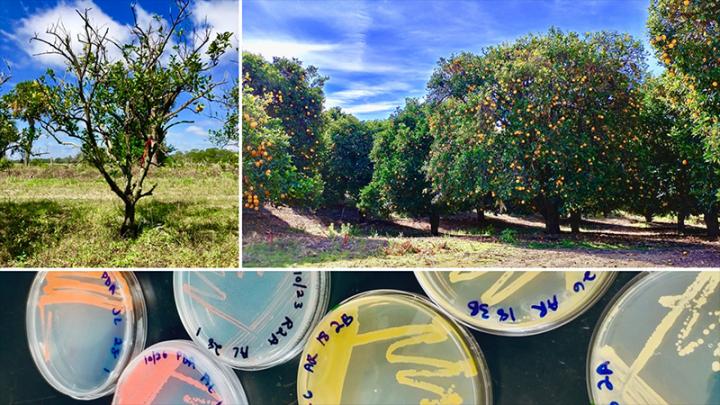Understanding disease-induced microbial shifts may reveal new crop management strategies

Orange fields and lab work
Credit: Dr. Nichole Ginnan
While humanity is facing the COVID-19 pandemic, the citrus industry is trying to manage its own devastating disease, Huanglongbing (HLB), also known as citrus greening disease. HLB is the most destructive citrus disease in the world. In the past decade, the disease has annihilated the Florida citrus industry, reducing orange production for juice and other products by 72%. Candidatus Liberibacter asiaticus (CLas) is the microbe associated with the disease.
It resides in the phloem of the tree and, like many plant pathogens, is transmitted by insects during feeding events. Disease progression can be slow but catastrophic. Symptoms begin with blotchy leaves, yellow shoots, and stunting, and progress into yield decline, poor quality fruit, and eventually death.
Currently, the only thing citrus growers can do to protect their crops from HLB is control the insect vector. Dozens of researchers are trying to find ways to manage the disease, using strategies ranging from pesticides to antibiotics to CLas-sniffing dogs. Understanding the plant microbiome, an exciting new frontier in plant disease management, is another strategy.
Dr. Caroline Roper and first author Dr. Nichole Ginnan at the University of California, Riverside led a large research collaboration that sought to explore the microbiome’s role in HLB disease progression. Their recent article in Phytobiomes Journal, “Disease-Induced Microbial Shifts in Citrus Indicate Microbiome-Derived Responses to Huanglongbing,” moves beyond the single-snapshot view of the microbial landscape typical of microbiome research. Their holistic approach to studying plant-microbe interactions captured several snapshots across three years and three distinct tissue types (roots, stems, and leaves). What is so interesting about this research is the use of amplicon (16S and ITS) sequencing to capture the highly intricate and dynamic role of the microbiome (both bacterial and fungal) as it changes over the course of HLB disease progression.
Ginnan et al. surmised that HLB created a diseased-induced shift of the tree’s microbiome. Specifically, the researchers showed that as the disease progresses, the microbial diversity increases. They further investigated this trend to find that the increase in diversity was associated with an increase in putative pathogenic (disease-causing) and saprophytic (dead tissue-feeding) microbes. They observed a significant drop in beneficial microbes in the early phases of the disease. Arbuscular mycorrhizal fungi (AMF) were one such beneficial group that the authors highlighted as showing a drastic decline in relative abundance.
The depletion of key microbial species during disease might be opening the door for other microbes to invade. Certain resources may become more or less available, allowing different microbes to prosper. Dr. Roper and Dr. Ginnan hypothesize that when HLB begins, this depletion event triggers a surge of beneficial microbes to come to the aid of the citrus tree. They suspect that the microbes are initiating an immune response to protect the host.
As the disease proliferates, the citrus tree and its microbiome continue to change. Dr. Ginnan, the lead author on this study, found that there was an enrichment of parasitic and saprophytic microorganisms in severely diseased roots. The enrichment of these microbes may contribute to disease progression and root decline, one side effect of HLB.
Survivor trees, or trees that did not progress into severe disease, had a unique microbial profile as well. These trees were enriched with putative symbiotic microbes like Lactobacillus sp. and Aureobasidium sp. This discovery led the researchers to identify certain microbes that were associated with slower disease progression.
Dr. Ginnan says their “aha” moment during the research was in the data analysis. “Originally we were looking for taxa that increased and decreased in relative abundance as disease rating increased,” she said. “Our differential abundance analysis ended up revealing clear enrichment patterns replicated in multiple taxa.” This is the moment they began to develop the individual patterns they were seeing into a broader disease model.
This research is the foundation for future projects and collaborations that the authors are excited to continue to develop. They are motivated by the potential function of the microbiome to manage crop diseases. In the near future, they hope that these discoveries and an understanding of beneficial microbes can help establish a microbiome-mediated treatment plan to protect crops from diseases like HLB. In addition, the model they’ve developed can be applied to understanding diseases of other tree crop systems.
###
This research article was a part of Dr. Nichole Ginnan’s Ph.D. thesis under the mentorship of Dr. Caroline Roper (the lead researcher). Dr. Ginnan is now a Postdoctoral Researcher in Dr. Maggie Wagner’s Lab at the University of Kansas. She hopes to continue in academia with a research faculty position. Dr. Caroline Roper is a tenured professor at the University of California Riverside. She mentors several Ph.D. students, undergrads, and postdoctoral scholars on cutting edge research in plant-microbe interactions.
All latest news from the category: Agricultural and Forestry Science
Newest articles

Innovative 3D printed scaffolds offer new hope for bone healing
Researchers at the Institute for Bioengineering of Catalonia have developed novel 3D printed PLA-CaP scaffolds that promote blood vessel formation, ensuring better healing and regeneration of bone tissue. Bone is…

The surprising role of gut infection in Alzheimer’s disease
ASU- and Banner Alzheimer’s Institute-led study implicates link between a common virus and the disease, which travels from the gut to the brain and may be a target for antiviral…

Molecular gardening: New enzymes discovered for protein modification pruning
How deubiquitinases USP53 and USP54 cleave long polyubiquitin chains and how the former is linked to liver disease in children. Deubiquitinases (DUBs) are enzymes used by cells to trim protein…



